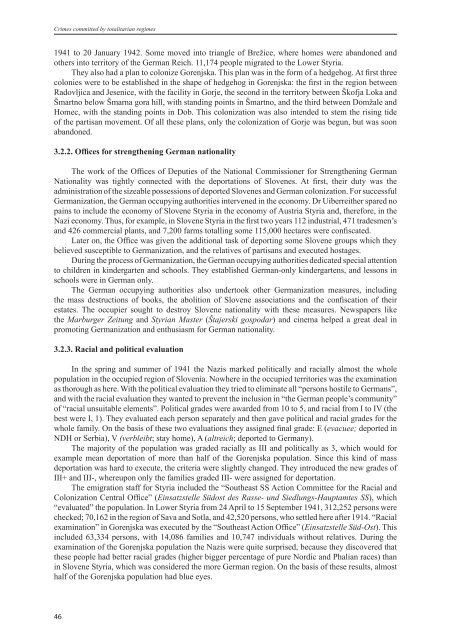crimes committed by totalitarian regimes - Ministrstvo za pravosodje
crimes committed by totalitarian regimes - Ministrstvo za pravosodje
crimes committed by totalitarian regimes - Ministrstvo za pravosodje
You also want an ePaper? Increase the reach of your titles
YUMPU automatically turns print PDFs into web optimized ePapers that Google loves.
Crimes <strong>committed</strong> <strong>by</strong> <strong>totalitarian</strong> <strong>regimes</strong><br />
1941 to 20 January 1942. Some moved into triangle of Brežice, where homes were abandoned and<br />
others into territory of the German Reich. 11,174 people migrated to the Lower Styria.<br />
They also had a plan to colonize Gorenjska. This plan was in the form of a hedgehog. At first three<br />
colonies were to be established in the shape of hedgehog in Gorenjska: the first in the region between<br />
Radovljica and Jesenice, with the facility in Gorje, the second in the territory between Škofja Loka and<br />
Šmartno below Šmarna gora hill, with standing points in Šmartno, and the third between Domžale and<br />
Homec, with the standing points in Dob. This coloni<strong>za</strong>tion was also intended to stem the rising tide<br />
of the partisan movement. Of all these plans, only the coloni<strong>za</strong>tion of Gorje was begun, but was soon<br />
abandoned.<br />
3.2.2. Offices for strengthening German nationality<br />
The work of the Offices of Deputies of the National Commissioner for Strengthening German<br />
Nationality was tightly connected with the deportations of Slovenes. At first, their duty was the<br />
administration of the sizeable possessions of deported Slovenes and German coloni<strong>za</strong>tion. For successful<br />
Germani<strong>za</strong>tion, the German occupying authorities intervened in the economy. Dr Uiberreither spared no<br />
pains to include the economy of Slovene Styria in the economy of Austria Styria and, therefore, in the<br />
Nazi economy. Thus, for example, in Slovene Styria in the first two years 112 industrial, 471 tradesmen’s<br />
and 426 commercial plants, and 7,200 farms totalling some 115,000 hectares were confiscated.<br />
Later on, the Office was given the additional task of deporting some Slovene groups which they<br />
believed susceptible to Germani<strong>za</strong>tion, and the relatives of partisans and executed hostages.<br />
During the process of Germani<strong>za</strong>tion, the German occupying authorities dedicated special attention<br />
to children in kindergarten and schools. They established German-only kindergartens, and lessons in<br />
schools were in German only.<br />
The German occupying authorities also undertook other Germani<strong>za</strong>tion measures, including<br />
the mass destructions of books, the abolition of Slovene associations and the confiscation of their<br />
estates. The occupier sought to destroy Slovene nationality with these measures. Newspapers like<br />
the Marburger Zeitung and Styrian Master (Štajerski gospodar) and cinema helped a great deal in<br />
promoting Germani<strong>za</strong>tion and enthusiasm for German nationality.<br />
3.2.3. Racial and political evaluation<br />
In the spring and summer of 1941 the Nazis marked politically and racially almost the whole<br />
population in the occupied region of Slovenia. Nowhere in the occupied territories was the examination<br />
as thorough as here. With the political evaluation they tried to eliminate all “persons hostile to Germans”,<br />
and with the racial evaluation they wanted to prevent the inclusion in “the German people’s community”<br />
of “racial unsuitable elements”. Political grades were awarded from 10 to 5, and racial from I to IV (the<br />
best were I, 1). They evaluated each person separately and then gave political and racial grades for the<br />
whole family. On the basis of these two evaluations they assigned final grade: E (evacuee; deported in<br />
NDH or Serbia), V (verbleibt; stay home), A (altreich; deported to Germany).<br />
The majority of the population was graded racially as III and politically as 3, which would for<br />
example mean deportation of more than half of the Gorenjska population. Since this kind of mass<br />
deportation was hard to execute, the criteria were slightly changed. They introduced the new grades of<br />
III+ and III-, whereupon only the families graded III- were assigned for deportation.<br />
The emigration staff for Styria included the “Southeast SS Action Committee for the Racial and<br />
Coloni<strong>za</strong>tion Central Office” (Einsatzstelle Südost des Rasse- und Siedlungs-Hauptamtes SS), which<br />
“evaluated” the population. In Lower Styria from 24 April to 15 September 1941, 312,252 persons were<br />
checked; 70,162 in the region of Sava and Sotla, and 42,520 persons, who settled here after 1914. “Racial<br />
examination” in Gorenjska was executed <strong>by</strong> the “Southeast Action Office” (Einsatzstelle Süd-Ost). This<br />
included 63,334 persons, with 14,086 families and 10,747 individuals without relatives. During the<br />
examination of the Gorenjska population the Nazis were quite surprised, because they discovered that<br />
these people had better racial grades (higher bigger percentage of pure Nordic and Phalian races) than<br />
in Slovene Styria, which was considered the more German region. On the basis of these results, almost<br />
half of the Gorenjska population had blue eyes.<br />
46




